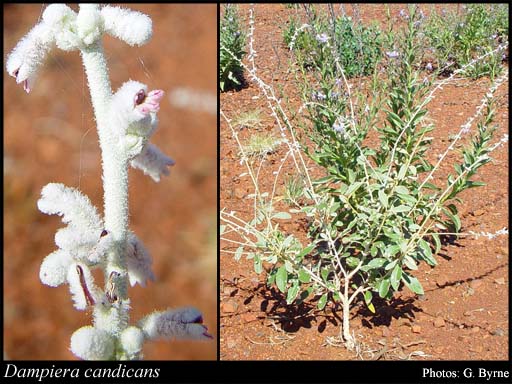- Reference
- Fragm. (Mueller) 10:86-87 (1877)
- Conservation Code
- Not threatened
- Naturalised Status
- Native to Western Australia
- Name Status
- Current
Upright-spreading shrub, 0.3-0.7(-1) m high, with dentate leaves. Fl. pink-violet/red-brown/white-cream, Mar to Oct. Sand or stony soils, laterite. Sandplains, low hills.

Scientific Description
Stems unribbed. Leaves flat, 10-60 mm long, 5-25 mm wide, Indumentum present, with sparse, dendritic hairs; margins entire. Bracteoles present, 0.5-1 mm long, hairy, with hairy hairs. Pedicel absent (flowers sessile). Calyx lobes absent. Corolla mauve or purple, 5-6 mm long, auriculate, not spurred, hairy on the outside, with dense, dendritic hairs, glabrous on the inside; central lobes 1-2 mm long, with wings; outer lobes 2.5-3 mm long, wings present on both sides, 0-0.5 mm wide. Anthers connate. Ovary inferior, not gibbose; style 2.5-3 mm long, glabrous; indusium single, glabrous; ovules one or two. Flowers in March, April, May, June, July, August, September and October. Occurs in the Pilbara (PIL), Gascoyne (GAS), Gibson Desert (GD), Great Sandy Desert (GSD), Little Sandy Desert(LSD), Dampier land (DL), Ord-Victoria Plains (OVP), Tanami (TAN) and Northern Kimberly (NK) IBRA Region(s), of the Northern (N) and Eremaean (E) Botanical Province.
Distribution
- IBRA Regions
- Dampierland, Gascoyne, Gibson Desert, Great Sandy Desert, Little Sandy Desert, Ord Victoria Plain, Pilbara, Tanami.
- IBRA Subregions
- Ashburton, Chichester, Fortescue, Hamersley, Lateritic Plain, Mackay, McLarty, Pindanland, Roebourne, Rudall, South Kimberley Interzone, Tanami Desert, Trainor.
- Local Government Areas (LGAs)
- Ashburton, Broome, Derby-West Kimberley, East Pilbara, Halls Creek, Ngaanyatjarraku, Port Hedland, Wiluna.